- Joined
- Nov 14, 2018
- Messages
- 4
- Reaction score
- 908
The Mystery of the Giant Clams of the Red Sea and Indian Ocean
by Dan Killam (originally published on the Clamsplaining blog)
by Dan Killam (originally published on the Clamsplaining blog)
I have always been fascinated by scientific discoveries that are hanging right in front of our noses. Cryptic species are one such surprise. Sometimes, researchers using genetic sequencing are surprised to discover that a group of animals that all look the same from the outside are actually reproductively isolated from each other; separate twigs on the tree of life. This surprise has happened over and over in the history of natural science.
It turns out such puzzles are frequent among the giant clams. These unusual bivalves are specialists in coral reef environments, growing to large size with the help of symbiotic algae that create sugars through photosynthesis. Within the genus Tridacna there are ~10 accepted species which vary in size, shape, color and mode of life.
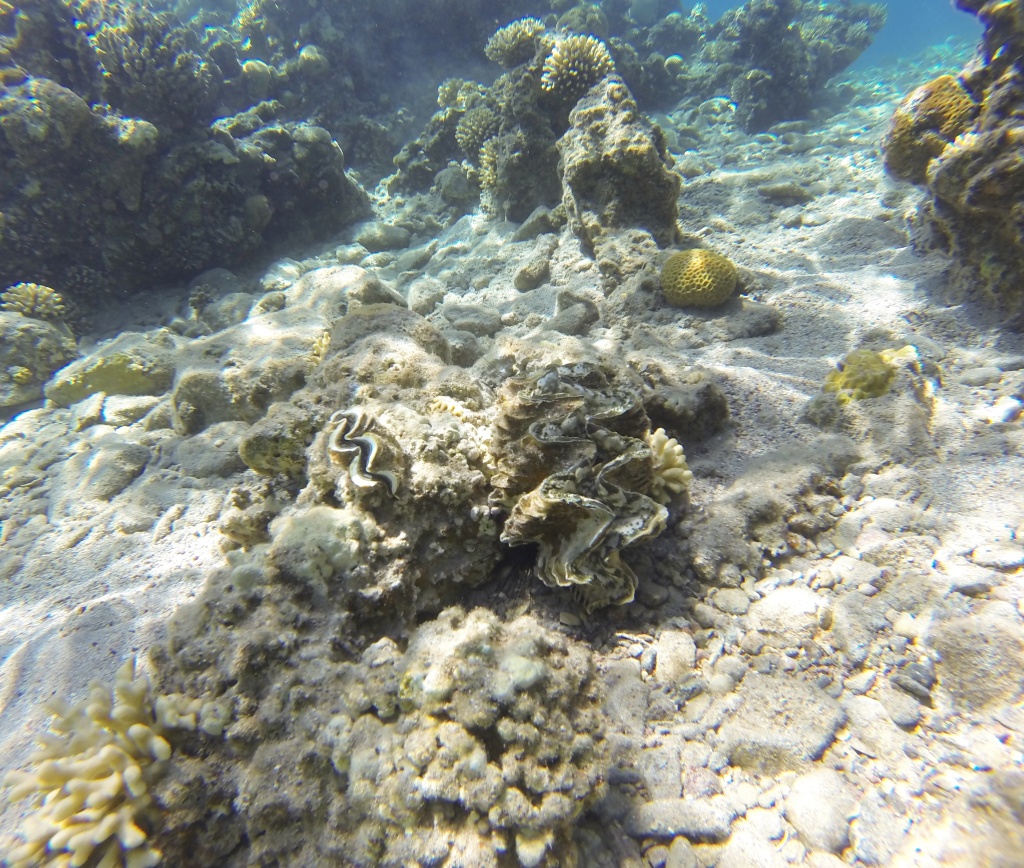
Tridacna squamosina (right) sitting next to the small giant clam T. maxima (left) on the Israeli Red Sea coast
I specialize in the three species known (so far) from the Red Sea, including the small giant clam Tridacna maxima and the fluted giant clam T. squamosa, which are both found worldwide, all the way from the Red Sea to down past the equator along the Great Barrier Reef. The third local species, T. squamosina is more unusual, so far being only known from the Red Sea (an endemic species). T. squamosina is an example of a cryptic species, having previously been assumed to be a local variant of T. squamosa. It looks pretty similar, with long scutes (flap-like appendages) protruding from its shell, thought to help stabilize it on the flat bottom of loose coral rubble. But unlike T. squamosa, T. squamosina lives exclusively at the top of the reef in the shallowest waters closest to the sun. It has a very angular, zig-zag pattern in its plications (the wavy shapes at the edge of the shell) and a characteristic pair of green stripes where the soft tissue meets the edges of the shell. The soft tissue is covered with warty protuberances.
Pictures of details of T. squamosina from Richter et al. 2008
It was only first described in detail in the early 2000s, when an international team of researchers figured out using genetic sequencing that it was a distinct species and named it T. costata. They noted that in their surveys all around the shores of the Red Sea, they only found 13 live specimens, making it an extremely rare and possibly endangered species. Fossil specimens on local reefs appeared to be much more common, suggesting it had a much larger population in the past. Then in 2011, another team at the Natural History Museum in Vienna discovered a shell of one had been forgotten in its collection for over 100 years. Rudolf Sturany, the researcher on the 1895 research cruise who had originally collected the clam, had called it T. squamosina.
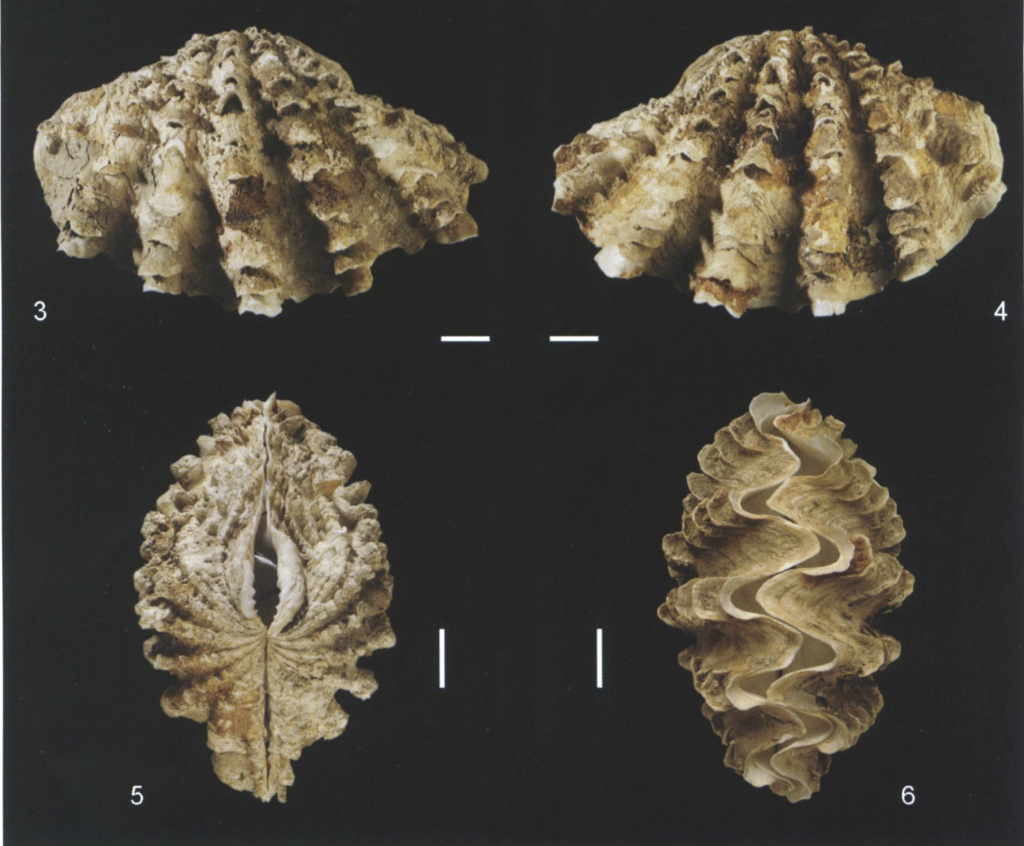
The T. squamosina shell in the collection of the Museum of Natural History in Vienna (from Huber and Eschner, 2011)
In taxonomy (the science of naming and classifying organisms), the first team to name the species wins, so the name T. costata was synonymized (retired) in favor of the earlier name T. squamosina, which became the name of record. It must be annoying to spend so much time working to name a species and then discover you had been scooped over a century before! But such is science.
(Image missing in original article)

A mystery clam thought to be T. squamosina, later identified as T. elongatissima found off of Mozambique by iNaturalist user bewambay
The strange part was that there were some murmurs over the last few years that T. squamosina was not only found in the Red Sea, but also had been seen along the coast of Africa as far south as Kenya, Mozambique and Madagascar. Divers and snorkelers had taken pictures of a giant clam that did indeed look strangely like T. squamosina, with a zigzag shell opening and green stripes at the edge of its tissue. But some aspects of these individuals seemed off. In the Red Sea, T. squamosina lives freely, not embedded in the coral as these pictures showed, and the geometry of the angles of the shell seemed a bit different. It also would be difficult for T. squamosina to be connected in population from the Red Sea all the way South to Mozambique, as there are natural barriers which would prevent its planktonic larvae from riding currents to intermix between the two regions. When populations are separated by a barrier, the flow of genes between them is cut off and evolution begins to separate the populations from each other until they are separate species, a process called allopatric speciation.
(Image missing in original article)

A large specimen of T. elongatissima observed by iNaturalist user dawngoebbels off of Kenya
I figured that someday, researchers would collect tissue samples from these mystery clams to settle whether they were actually T. squamosina or something else. And this year, a team did just that, traveling along the coast of Mozambique, Madagascar, Kenya and other places, collecting samples of tissue to compare how all the different clams they saw were related in a family tree. They genetically sequenced these “clamples” and in the process, found that the mystery clams were a new cryptic species, which they called T. elongatissima!
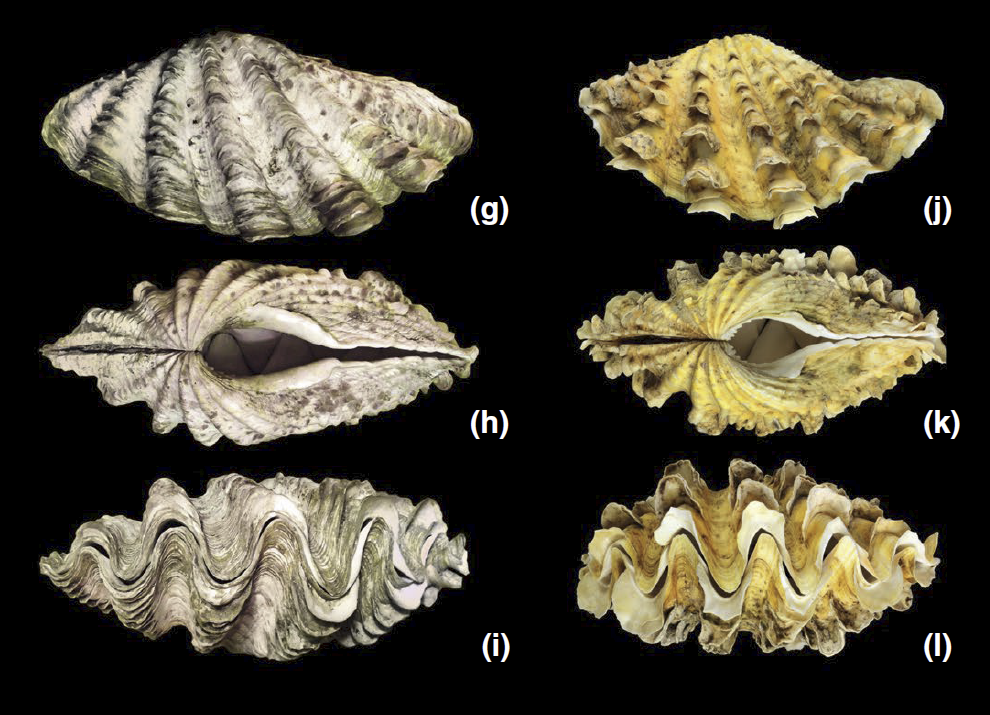
Shells of T. elongatissima from the Fauvelot et al. 2020 paper
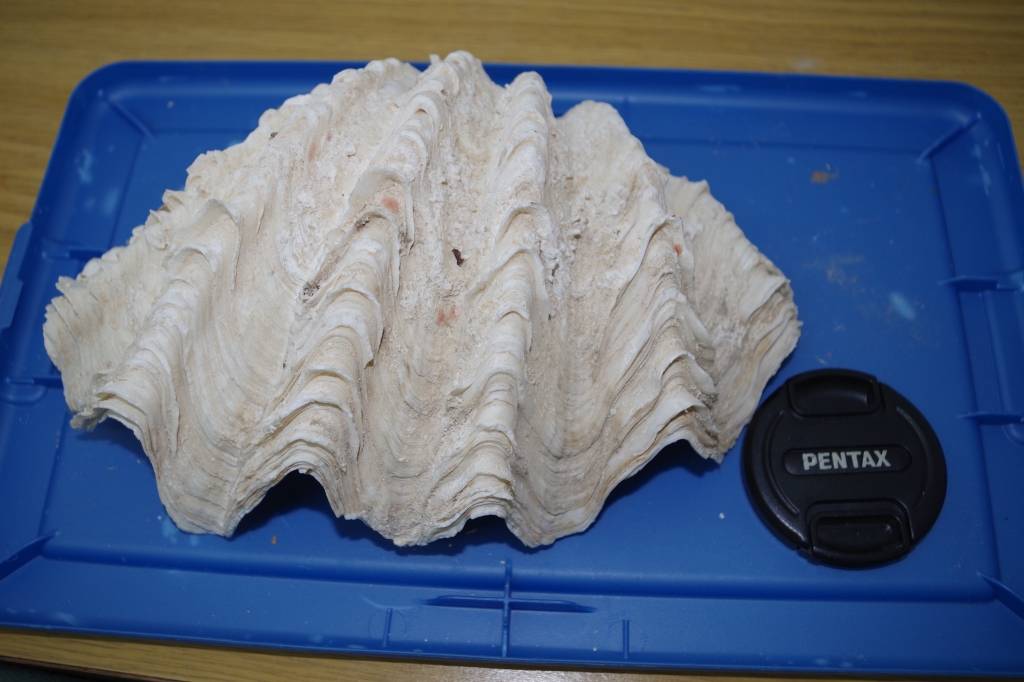
For comparison, a shell of T. squamosina collected off of Sinai, Egypt. You can see why they’re easy to mix up!
T. elongatissima closely resembles T. squamosina, and they are sister species on the bivalve family tree. It’s hard to tell them apart without training. Even a professional would probably mix some of them up if they were all placed sitting next to each other. The major differences appear to relate to shell shape, with T. elongatissima having a less symmetrical shell than T. squamosina, and a bigger opening at the rear hinge for a foot to poke through. The symmetrical shell and closing of the foot opening may represent changes that T. squamosina took on to adapt to be able to sit freely on the bottom, rather than embedding in the coral like T. elongatissima seems to prefer. If you’ve read this far, you may be thinking “Who cares? A clam’s a clam and these look practically the same. Aren’t you just splitting clams at this point?” At the end of the day, a species is a man-made concept; an organizing tool for use by us humans. Species are the characters in our reconstruction of the history of the world. What can we learn about the world by having identified this species T. elongatissima?
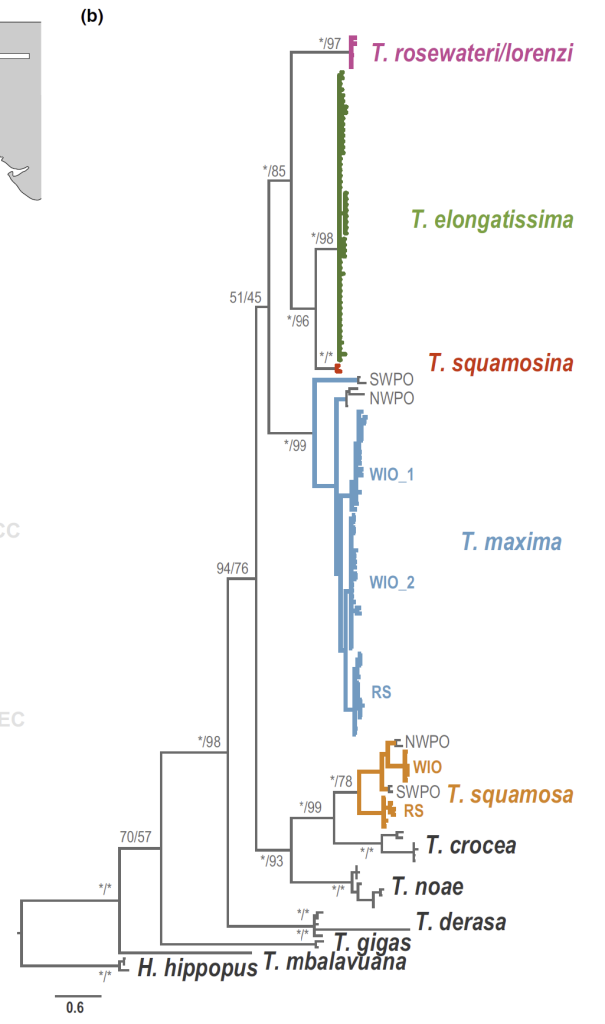
A giant clam family tree! Notice T. squamosina and T. elongatissima right next to each other.
The researchers behind the new paper discuss that based on statistical analyses of the genetic differences between the species, the most recent common ancestor for T. elongatissima and T. squamosina probably lived more than 1.4 million years ago! Some researchers have previously suggested that T. squamosina probably began its development as a separate species due to geographic isolation by low sea level, caused by repeated glaciations. With so much water trapped as ice on land during this period, the narrow Strait of Bab al Mandab, currently the gateway to the Red Sea, became a land barrier as sea level fell (kind of like opposite of the Bering Sea land bridge that formed allowing humans to migrate to the Americas). Ancestral clams trapped on the Northern end of this barrier were proposed to have evolved to become the rare T. squamosina.
This has occurred with a variety of species that became Red Sea endemics (meaning they are unique species that evolved in the Red Sea and are found nowhere else), including a unique crown of thorns starfish. The issue is that during this time of low sea level, the Red Sea went through periods where it was a rather unfriendly place for clams to live. All sorts of creatures went extinct in the period when the sea was repeatedly cut off, because the water became extremely salty, along with other unfriendly changes. So it’s unlikely T. squamosina would be present for us to see today if it only lived in the Red Sea throughout the entire length of time.
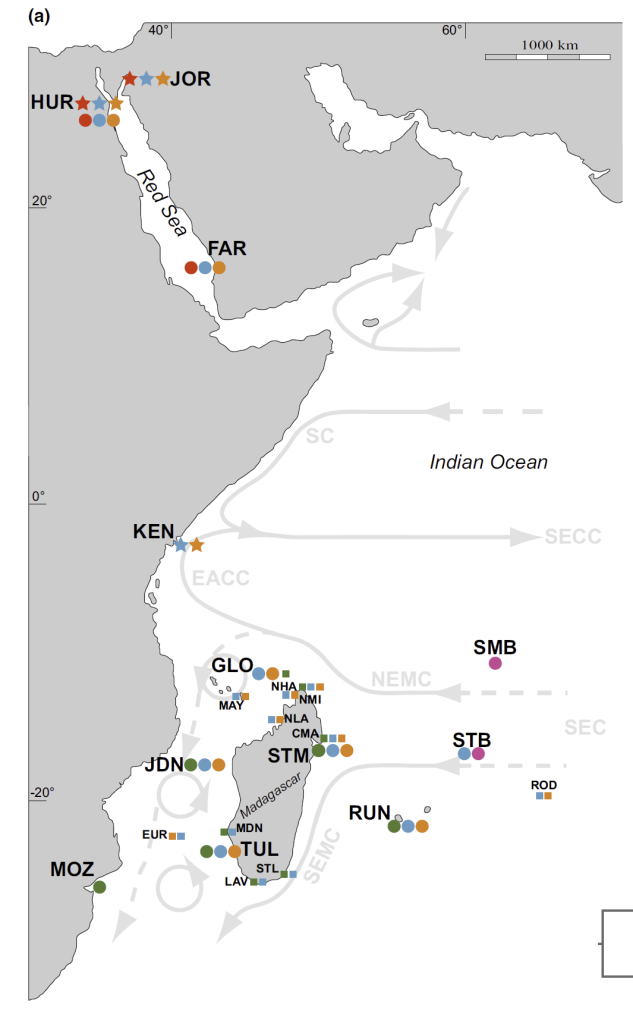
A map from Fauvelot et al. 2020 showing the distributions of different giant clams the researchers identified along the coasts of Africa and the Red Sea. Notice the bright red dots representing T. squamosina, only found in the Red Sea, while green dots represent T. elongatissima. Notice how the currents (arrows) seem to meet and then go offshore from Kenya. More on that in the next paragraph.
The researchers of this new paper propose that T. squamosina was more likely to have initially branched off due to the barrier of the Horn of Africa. The seas off of Kenya and Somalia harbor a meeting of southward and northward currents which then group and head offshore, away from the reefs that giant clam larvae are trying to get to. So any tiny floating planktonic clam larvae would experience a strong “headwind” preventing them from crossing that point. It would also mean that during times that the Red Sea was not a happy place to be a clam, T. squamosina may have found refuge on the coasts of places like Eritrea, Oman and possibly even as far as Pakistan. During times when sea levels rose and Red Sea conditions became friendlier, it recolonized the area.
As far as we know, the Red Sea is the only place T. squamosina is now found, but it may well be present elsewhere like Yemen or Oman. If T. squamosina was found in other regions, it would be tremendously important for its conservation. Right now, the species is thought to be extremely rare, with a very small native range. If it inhabited a broader area, that would mean more reservoirs of genetic diversity. This would reduce the odds that it will go extinct as reefs are put under stress from climate change, pollution and overharvesting. To survive as a species, it helps to not put all your eggs in one basket. If you’re only found in one small place, it increases the chances that a disaster (like climate change) will wipe you out.
The only way we will know for sure is to visit reefs in understudied places like Yemen, Oman, Pakistan, Eritrea and Somalia, to understand the richness of the giant clams present. These areas are understudied for various reasons: lack of research funding for non-Western researchers, lack of interest from the scientific community too focused on familiar places, and geopolitical situations that make it difficult to conduct research. But I hope someday to collaborate with people in these countries to better understand the giant clams present in such understudied regions of the globe. It is virtually certain that there are more species of giant clams, both alive and as fossils, waiting to be discovered.
This article is republished with permission from the author. The original article (and many more) was originally published on the Clamsplaining blog.












